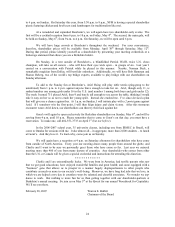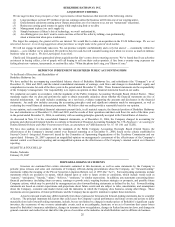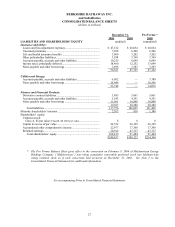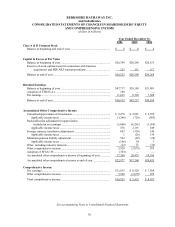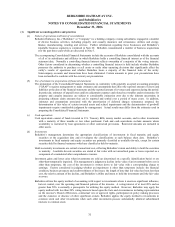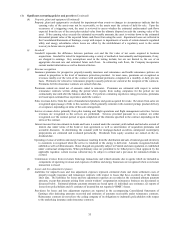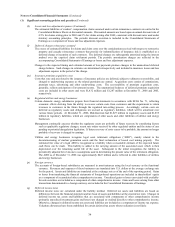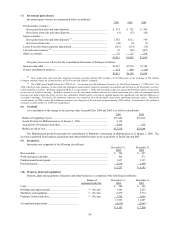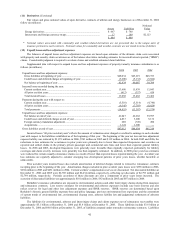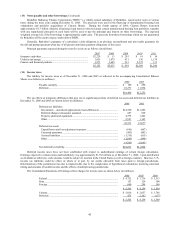Berkshire Hathaway 2006 Annual Report Download - page 34
Download and view the complete annual report
Please find page 34 of the 2006 Berkshire Hathaway annual report below. You can navigate through the pages in the report by either clicking on the pages listed below, or by using the keyword search tool below to find specific information within the annual report.33
(1) Significant accounting policies and practices (Continued)
(h) Property, plant and equipment (Continued)
Property, plant and equipment is evaluated for impairment when events or changes in circumstances indicate that the
carrying value of the assets may not be recoverable, or the assets meet the criteria of held for sale. Upon the
occurrence of a triggering event, the asset is reviewed to assess whether the estimated undiscounted cash flows
expected from the use of the asset plus residual value from the ultimate disposal exceeds the carrying value of the
asset. If the carrying value exceeds the estimated recoverable amounts, the asset is written down to the estimated
discounted present value of the expected future cash flows from using the asset. Impairment losses are reflected in
the Consolidated Statements of Earnings, except with respect to impairments of assets of certain domestic regulated
utility and energy subsidiaries where losses are offset by the establishment of a regulatory asset to the extent
recovery in future rates is probable.
(i) Goodwill
Goodwill represents the difference between purchase cost and the fair value of net assets acquired in business
acquisitions. Goodwill is tested for impairment using a variety of methods at least annually and impairments, if any,
are charged to earnings. Key assumptions used in the testing include, but are not limited to, the use of an
appropriate discount rate and estimated future cash flows. In estimating cash flows, the Company incorporates
current market information as well as historical factors.
(j) Revenue recognition
Insurance premiums for prospective property/casualty insurance and reinsurance and health reinsurance policies are
earned in proportion to the level of insurance protection provided. In most cases, premiums are recognized as
revenues ratably over the term of the contract with unearned premiums computed on a monthly or daily pro rata
basis. Premiums for retroactive reinsurance property/casualty policies are earned at the inception of the contracts.
Premiums for life reinsurance contracts are earned when due.
Premiums earned are stated net of amounts ceded to reinsurers. Premiums are estimated with respect to certain
reinsurance contracts written during the period where reports from ceding companies for the period are not
contractually due until after the balance sheet date. For policies containing experience rating provisions, premiums
are based upon estimated loss experience under the contract.
Sales revenues derive from the sales of manufactured products and goods acquired for resale. Revenues from sales are
recognized upon passage of title to the customer, which generally coincides with customer pickup, product delivery
or acceptance, depending on terms of the sales arrangement.
Service revenues derive primarily from pilot training and flight operations and flight management activities. Service
revenues are recognized as the services are performed. Services provided pursuant to a contract are either
recognized over the contract period, or upon completion of the elements specified in the contract, depending on the
terms of the contract.
Interest income from investments in bonds and loans is earned under the constant yield method and includes accrual of
interest due under terms of the bond or loan agreement as well as amortization of acquisition premiums and
accruable discounts. In determining the constant yield for mortgage-backed securities, anticipated counterparty
prepayments are estimated and evaluated periodically. Dividends from equity securities are earned on the ex-
dividend date.
Operating revenue of utilities and energy businesses resulting from the distribution and sale of natural gas and electricity
to customers is recognized when the service is rendered or the energy is delivered. Amounts recognized include
unbilled as well as billed amounts. Rates charged are generally subject to Federal and state regulation or established
under contractual arrangements. When preliminary rates are permitted to be billed prior to final approval by the
applicable regulator, certain revenue collected may be subject to refund and a provision for estimated refunds is
accrued.
Commission revenue from real estate brokerage transactions and related amounts due to agents which are included as
components of operating revenues and expenses of utilities and energy businesses are recognized when a real estate
transaction is closed.
(k) Losses and loss adjustment expenses
Liabilities for unpaid losses and loss adjustment expenses represent estimated claim and claim settlement costs of
property/casualty insurance and reinsurance contracts with respect to losses that have occurred as of the balance
sheet date. The liabilities for losses and loss adjustment expenses are recorded at the estimated ultimate payment
amounts, except that amounts arising from certain workers’ compensation reinsurance business are discounted as
discussed below. Estimated ultimate payment amounts are based upon (1) individual case estimates, (2) reports of
losses from policyholders and (3) estimates of incurred but not reported (“IBNR”) losses.
Provisions for losses and loss adjustment expenses are reported in the accompanying Consolidated Statements of
Earnings after deducting amounts recovered and estimates of amounts recoverable under reinsurance contracts.
Reinsurance contracts do not relieve the ceding company of its obligations to indemnify policyholders with respect
to the underlying insurance and reinsurance contracts.



